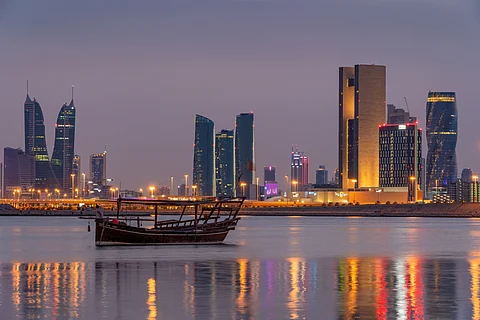
- Destinations
- Experiences
- Stay
- What's new
- Celebrating People
- Responsible Tourism
- CampaignsCampaigns
- SubscribeSubscribe
- Buy Now

Bahrain's capital and largest city, Manama, was a trading centre in the Arabian Gulf for centuries and still retains elements of its historic past in the urban landscape today. It rivals Doha and Dubai with its vast, air-conditioned shopping malls and eye-watering skyscrapers, but its proud heritage as a busy port town is equally evident—probably none more so than in the Manama Souq.
Manama's economy in the early 20th century relied heavily on pearling and shipbuilding, which employed several hundred people. However, with the onset of the Great Depression in the 1930s and the discovery of oil in 1932, the country’s economy began to shift towards the liquid black gold and led to a collapse of the pearling sector. Today, the city is a cosmopolitan place that attracts immigrants and expatriates from all over the world.
Here are the top places to visit in Manama during your Bahrain tour.
The largest mosque in the country stands as a stunning masterpiece of Islamic architecture and serves as an educational centre on Islam. It was named in honour of Ahmed Al-Fateh, the first ruler of Bahrain from the ruling family. Covering an area of 6,500 sq m, the building accommodates 7,000 worshippers and includes separate prayer halls for men and women, a library, an Islamic institute, and a Quran memorisation school. Its grand courtyard is adorned with a fibreglass dome, one of the largest of its kind in the world. Elegant chandeliers and lamps hang like necklaces and bracelets, casting a golden glow that illuminates the mosque’s arched walls, teakwood doors, and captivating Arabic Kufic calligraphy that decorates the walls.
The Al-Fateh Grand Mosque is open Saturday through Thursday, 9 AM to 4 PM, and is closed on Fridays.
The Bahrain National Museum was inaugurated in 1988 and is considered one of the finest museums of its kind in the Gulf region. From the Dilmun civilisation through the Tylos period and the Islamic era to the more recent stages of Bahrain's history, the museum transports visitors to various worlds and eras with artefacts discovered at numerous archaeological sites across the country. It exhibits Bahrain’s 6,000-year-old customs, traditions, and crafts before the discovery of oil, with intricate models that recreate, for instance, a bustling traditional marketplace filled with vendors and artisans. For a unique experience, visitors can also enjoy a boat tour near the museum.
The building is characterised by its white travertine marble façade and is centrally located on an artificial peninsula overlooking the island of Muharraq. The museum complex is composed of two connected buildings with approximately 20,000 sq m of floor space. The main building houses the permanent exhibition area, temporary exhibition halls, an art gallery, a lecture hall, gift shop, and café.
The Manama Souq is Bahrain’s oldest and main souq, having been around since 1926. Parts of it have been redeveloped, modernised, and pedestrianised, but you can still explore the old part and all the traditional stalls, many of which have been passed down through families over the decades.
Visitors can buy everything from spices, handwoven rugs, and tailored suits to traditional Bahraini clothes and gold; just make sure to sharpen your bargaining skills beforehand. Make a pit stop at Haji Gahwa, one of Bahrain’s oldest traditional cafés, or the Swagat Restaurant which sells Indian cuisine at affordable prices.
Bab Al Bahrain is located at the entrance to the Manama Souq. Built by Sir Charles Dalrymple Belgrave, a British adviser to the royals, in 1949, this “Gateway to Bahrain” originally stood where huge dhows (traditional cargo boats) laden with goods came to dock, as this was Bahrain's original customs pier. It has since undergone many big changes over the years. The Ministry of Culture undertook a project to preserve it as a cultural landmark and thus restored it to its former glory, eventually moving its tourism sector offices and visitor’s centre into the building.
Beit Al Quran is one of Bahrain’s most prominent and beautiful museums, showcasing Islamic architecture, intricate designs, and elegant Arabic calligraphy. The museum holds approximately 10,000 rare Quran copies and manuscripts from around the world. Among its treasures is a rare Quran manuscript written during the time of Caliph Uthman bin Affan, the first printed Quran from Germany in 1694, and the earliest Latin-translated Quran from Switzerland, dating back to around 1548. Its rich library has over 60,000 publications primarily focused on Quranic studies in Arabic, English, and French.
Beit Al Quran’s beauty is evident in its design, which reflects traditional Islamic architecture. A stunning visual experience awaits, especially if visited at night when golden lighting reflects on the palm-lined exterior. The circular mosque, crowned by a stained-glass dome crafted in Britain, is one of the largest of its kind in the world. The elegant ceramic mihrab (a niche indicating the direction of the Kaaba) was crafted by a Turkish artist.
Opened in 2008, the Bahrain World Trade Center has sleek aesthetics and bold colours, creating an ultra-modern backdrop that is home to global corporations and luxury brands. The building has been recognised for its ground-breaking architecture and innovative design that integrates renewable energy solutions into a sophisticated office space. It is notable for its iconic twin wind turbines, which are integrated into the building's structures. These turbines harness the strong winds in the area to generate renewable energy, reducing the reliance on conventional energy sources. Other energy-reducing measures include innovative shading methods, deep gravel roofs that provide kinetic insulation, and energy-efficient lighting.
When you’re here, visit the nearby Moda Mall, which houses the largest brand portfolio of international fashion and jewellery designers, a wide selection of dining options, and additional wellness services.
